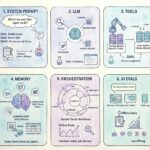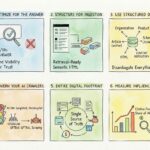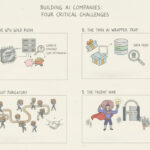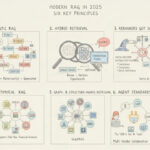Artificial Intelligence (AI) has evolved from a futuristic concept into a transformative business reality. For enterprises, the question is no longer if they should adopt AI, but how to do so effectively to drive growth, efficiency, and competitive advantage. Successful AI integration, however, is not merely a technological challenge; it is a strategic endeavor that requires a holistic assessment of an organization’s capabilities. This whitepaper introduces a comprehensive framework for evaluating enterprise AI readiness, based on six critical pillars: AI Strategy and Roadmap, Data Readiness, Technology and Infrastructure, Organization and Culture, Governance and Risk, and Ecosystem & Integration Strategy. By systematically assessing maturity across these domains, organizations can identify strengths, pinpoint weaknesses, and build a strategic roadmap for a successful and sustainable AI-powered future.
Beyond the Hype
The promise of AI is immense, offering the potential to revolutionize everything from customer experience and operational efficiency to product innovation and strategic decision-making. However, many organizations struggle to move from initial experimentation to scalable, value-generating AI implementation. The primary reason for this gap is often a lack of foundational readiness.
Without a clear strategy, high-quality data, a capable infrastructure, an aligned culture, and robust governance, AI initiatives are likely to falter, failing to deliver on their expected return on investment. This document provides business leaders, IT professionals, and strategists with a structured framework to measure their organization’s preparedness for AI adoption. By understanding your current state, you can chart a deliberate and effective course toward becoming an AI-driven enterprise.
The Six Pillars of AI Readiness
A Successful AI transformation rests on six interconnected pillars. An honest assessment across these areas is the first step toward building a successful AI program.
- AI Strategy and Roadmap: The vision and plan that aligns AI initiatives with core business objectives.
- Data Readiness: The quality, accessibility, and management of the data that fuels AI models.
- Technology and Infrastructure: The technical foundation required to build, deploy, and scale AI solutions.
- Organization and Culture: The human element—the skills, mindset, and structure needed to embrace AI.
- Governance and Risk: The policies and controls required to ensure AI is used responsibly, ethically, and securely.
- Ecosystem & Integration Strategy: The capability to select, integrate, and manage third-party AI solutions.

Pillar 1: AI Strategy and Roadmap
Strategy is the compass for your AI journey. Without it, even the most advanced technology can lead you nowhere. A robust AI strategy is not a standalone document; it is woven into the fabric of the overall business strategy.
Key Assessment Questions:
- Business Alignment: Is AI a stated priority for our business? Are AI use case success metrics clearly tied to organizational goals?
- Clear Roadmap: Do we have a defined strategy and roadmap for deploying AI solutions? Does it include a process for identifying and prioritizing use cases?
- Financial Commitment: Is there a financial strategy in place to properly fund our AI initiatives?
- Leadership Support: Is our AI strategy fully supported by executive leadership and the board of directors?
- Impact Measurement: Do we have a process to track and measure the business impact and ROI of our AI strategy?
An organization mature in this pillar has moved beyond ad-hoc projects to a portfolio of AI initiatives that are centrally funded, championed by leadership, and measured against key business performance indicators.
Pillar 2: Data Readiness
Data is the lifeblood of artificial intelligence. The performance, accuracy, and fairness of any AI model are fundamentally dependent on the data it is trained on. Therefore, data readiness is a non-negotiable prerequisite for success.
Key Assessment Questions:
- Data Quality and Availability: Do we have access to high-quality data streams for our critical AI use cases? Is our data relevant, accurate, and complete?
- Data Volume: Do we have a sufficient volume of historical data to train effective models?
- Accessibility: Is our data findable, clearly cataloged, and accessible to the teams that need it?
- Governance: Do we have clear data governance, ownership, and management policies in place?
- Infrastructure: Does our data infrastructure (e.g., data lakes, warehouses) support the demands of AI workloads?
A data-ready enterprise treats data as a strategic asset, with strong governance, robust infrastructure, and a culture of data stewardship that ensures its quality and accessibility.
Pillar 3: Technology and Infrastructure
A successful AI strategy requires a modern, scalable, and flexible technology stack. Legacy systems can hinder the development and deployment of AI solutions, making it crucial to assess and invest in the right infrastructure.
Key Assessment Questions:
- Scalability & Flexibility: Is our IT infrastructure scalable and flexible enough to support AI model training and deployment?
- Tooling: Do our teams have access to the necessary tools and platforms (e.g., cloud computing services, MLOps platforms) for AI development?
- Integration: Can our AI solutions be effectively integrated with our existing business systems and workflows?
- Security: Do we have robust security measures in place to protect our AI models, platforms, and associated data?
- Monitoring: Do we have processes for the ongoing monitoring and maintenance of deployed AI solutions to ensure performance and reliability?
Mature organizations leverage cloud platforms and modern architectures to provide their teams with the power and agility needed to build, deploy, and manage AI solutions at scale.
Pillar 4: Organization and Culture
Technology alone does not create value; people do. A successful AI transformation requires a significant focus on the human element, ensuring the organization has the right skills, structure, and mindset to adopt and leverage AI effectively.
Key Assessment Questions:
- Talent and Skills: Do we have a dedicated team or role for AI? Is our staff proficient in leveraging AI technologies relevant to their work?
- Upskilling: Does our company have training programs to upskill our staff in AI-related competencies?
- Buy-In: Are employees and middle management receptive to and fully embracing our AI strategy?
- Organizational Structure: Is our organization structured to realize the benefits of AI, or are significant changes needed?
- Change Management: Do we have a change management plan to address the organizational shifts brought about by AI?
An AI-ready culture is one of curiosity, continuous learning, and collaboration between business and technical teams. It is supported by a leadership that champions change and invests in its people.
Pillar 5: Governance and Risk
As AI becomes more powerful and integrated into critical business processes, the need for robust governance and risk management becomes paramount. This pillar ensures that AI is developed and used in a manner that is ethical, transparent, compliant, and secure.
Key Assessment Questions:
- Policy and Compliance: Do our AI solutions adhere to data privacy policies and business standards? Are we well-versed in and compliant with regional and international AI regulations?
- Bias and Fairness: Do we have processes to ensure our AI solutions are free of bias?
- Explainability: Are the models and approaches used by our AI solutions transparent and easily explainable (XAI)?
- Access Control: Is there a governance structure to manage access to our AI solutions and datasets?
- Security & Privacy: Can our AI solutions be reverse-engineered to identify personal information?
Leading organizations proactively establish an AI governance framework that addresses legal, ethical, and reputational risks, building trust with customers, employees, and regulators.
Pillar 6: Ecosystem & Integration Strategy
For most enterprises, AI success will be achieved by “renting” or “buying” specialized solutions rather than building everything in-house. This makes the ability to select, integrate, and manage a portfolio of external AI vendors a critical competency. This pillar focuses on becoming a smart consumer and integrator of AI technology.
Key Assessment Questions:
- Vendor Evaluation: Do we have a formal process for evaluating third-party AI vendors based on capability, security, ethics, and cost-effectiveness?
- Integration Capability: Is our technical architecture flexible enough to integrate with external AI services via APIs? Do we have the skills for this integration work?
- Partner Governance: How do we ensure our AI partners comply with our own data security, privacy, and ethical standards?
- Ecosystem Cohesion: Do we have a strategy to ensure different AI solutions from various vendors work together, avoiding data silos and fragmented workflows?
- Total Cost of Ownership (TCO): Do we have a model for evaluating the TCO of external AI, including subscription, integration, and maintenance costs?
A mature organization in this pillar has a deliberate strategy for managing its AI ecosystem, ensuring that partner solutions are secure, well-integrated, and deliver measurable business value.
How to Score Your Readiness
As you answer the key questions for each pillar, use the following scale to score your organization’s current maturity level. Be honest and objective in your assessment.
- 0 – Non-Existent: There is no activity, process, or awareness in this area. The concept has not been considered or addressed.
- 1 – Exploring: The organization is aware of the need in this area. Discussions have begun, but there are no formal plans, processes, or dedicated resources. Activities are ad-hoc and experimental.
- 2 – Basic: A foundational process or capability exists but is inconsistent, undocumented, or applied only in specific pockets of the organization. It is largely reactive.
- 3 – Minimum Required: A formal, documented process is in place and is applied consistently across relevant areas. The capability is reliable and meets the basic requirements for successful AI deployment.
- 4 – Industry Standard: The process is not only mature and consistently applied but is also actively measured, managed, and optimized. We are on par with or slightly ahead of our industry peers.
- 5 – Best in Class: Our capability in this area is a source of competitive advantage. It is highly optimized, predictive, automated, and integrated into the fabric of the business. We are seen as a leader by others in the industry.
From Assessment to Action: The AI Maturity Model
Assessing your organization against these six pillars is the first step. The next is to understand your overall maturity and use that insight to inform your roadmap.
- Laggard (0-1): AI is not on the radar or is purely experimental with no formal strategy.
- Novice (1-2): Initial, often siloed, AI projects are underway. Awareness is growing, but capabilities are limited.
- Practitioner (2-3): AI is recognized as important, with some established processes, dedicated resources, and successful use cases.
- Expert (3-4): AI is a strategic priority with strong governance, a skilled workforce, and scalable infrastructure. AI is delivering measurable business value.
- Leader (4-5): AI is deeply embedded in the business strategy and culture, driving innovation and competitive advantage across the organization.
Use your assessment scores to identify which pillars require the most immediate attention. A low score in “Data Readiness,” for example, might mean prioritizing investments in data governance and infrastructure before scaling model development.
Embarking on an AI journey without a clear understanding of your organization’s readiness is like setting sail without a map. The six-pillar framework presented in this whitepaper—Strategy, Data, Technology, Culture, Governance, and Ecosystem Integration—provides that map. By conducting a thorough and honest self-assessment, you can understand your starting point, identify your unique challenges and opportunities, and build a targeted, strategic roadmap. This deliberate approach will enable your organization to move beyond the hype, mitigate risks, and unlock the transformative potential of Artificial Intelligence.





